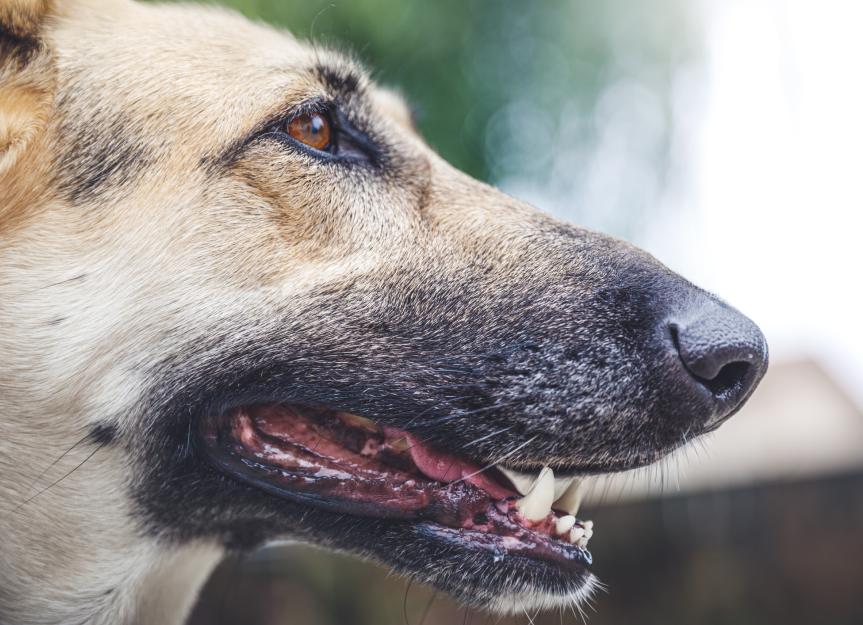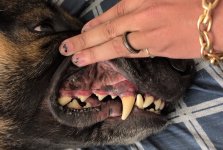- Oct 16, 2025
- 140
- 180
 Gingivitis: The Silent Killer
Gingivitis: The Silent Killer
Oftentimes I tell my friends: Gingivitis is the silent killer. This statement gets mixed reactions. Some people laugh, some people look at me like I'm crazy. Occasionally, I am asked what this statement means, and if you are still reading, welcome to my rant.
Disclaimer: You should always speak to your vet about anything to do with your dog's health, especially their dental health.
Disclaimer: You should always speak to your vet about anything to do with your dog's health, especially their dental health.
 What is Gingivitis?
What is Gingivitis?
Gingivitis, or gum disease, also known as periodontal disease, is inflammation caused by bacterial growth in the mouth around the tooth and gum line. Gingivitis is the first stage of a variety of dental diseases that can be dangerous and shorten your dog's lifespan by years.
→ Why is Gingivitis so Dangerous?
The bacteria in the mouth is important for digestion. However, stagnant food in the mouth can increase the amount of bad bacteria and enter the blood stream through the vasculature in the gums. Due to the mouth being so close to the brain, this can cause dangerous infections or sicknesses in extreme cases.
Need proof? A 2009 study on canine gum disease linked periodontal diseases to canine heart disease. Periodontal disease has also been linked to kidney damage and liver strain. Links to the studies are in the sources below.
The veterinarian oral health council has products on their page and informational posts about oral health on how to best protect your dog's mouth.
Need proof? A 2009 study on canine gum disease linked periodontal diseases to canine heart disease. Periodontal disease has also been linked to kidney damage and liver strain. Links to the studies are in the sources below.
The veterinarian oral health council has products on their page and informational posts about oral health on how to best protect your dog's mouth.
 Preventative Measures
Preventative Measures
→ Dental Cleanings
So, why is it important to get dental cleanings? Just like humans, our furry friends need to get dental cleanings so that the dentist can scrape along the lining of the gums and remove bacteria and potential plaque that may not be visible on the outside. No matter how diligently you brush your dog or your own teeth, it is always good to get dental cleanings to also have the dentist check the overall health of the teeth.
→ Teeth Brushing
According to a 2015 study on Beagles, brushing more frequently had greater effectiveness in retarding accumulation of plaque and calculus, and reducing the severity of pre-existing gingivitis.
→ Enzymatic tooth paste
I've tried many of the dog toothpastes on the market so you don't have to. However, I encourage you to find what works for you and your dogs. There are many different flavors and companies out there, and although most of the ingredients are the same, the taste and smell definitely are not.
My personal favorite flavors are chicken and beef, but the peanut butter, in my opinion leaves much to be desired.
My personal favorite flavors are chicken and beef, but the peanut butter, in my opinion leaves much to be desired.
→ Tooth Brushes
There are many different kinds of tooth brushes on the market for dogs. There are four main types of tooth brushes.
- Basic tooth brushes that look just like human tooth brushes.
- Dual ended toothbrushes (normally one side has a larger and the other side has a smaller brush)
- Dual sided tooth brushes (these brushes clean both sides of the teeth at the same time)
- Finger tooth brushes
→ Dental Chews
The purpose of dental chews is to help scrape the plaque off the teeth using your dog's natural chew time.
→ Deer Antlers
Deer antlers are often a controversial topic in the dog world due to the propensity for some dogs to crack teeth while chewing on them.
Deer antlers come in two types: whole and split. Split antlers are slightly easier for the dog to chew because the marrow in the antler is exposed and softer than the outside of the antler.
When choosing a chew for your dog, always remember to watch your dog as they chew, and be aware of how they chew. Super chewers or dogs who chew in aggressive ways may not be a good match for deer antlers.
Deer antlers come in two types: whole and split. Split antlers are slightly easier for the dog to chew because the marrow in the antler is exposed and softer than the outside of the antler.
When choosing a chew for your dog, always remember to watch your dog as they chew, and be aware of how they chew. Super chewers or dogs who chew in aggressive ways may not be a good match for deer antlers.
→ Raw Bones
There are two types of bones: weight bearing bones such as beef femur, and non-load bearing bones that are softer such as chicken feet, chicken wings, pigs feet, etc.
Personally, Murphy only likes natural chews, and will chew deer antlers, but she prefers beef femurs.
Personally, Murphy only likes natural chews, and will chew deer antlers, but she prefers beef femurs.
→ Dental Dog Treats
Greenies and Dental Sticks are some of the most popular dental dog treats that tout their ability to scrape tarter off of the dog's teeth. Results may vary.
→ Water Additives
There are a variety of water additives you can use-similar to mouth wash, that can help remove bacteria from your dog's mouth. I will link a few different kinds of mouth wash in the sources
→ Dental Wipes
Dental Wipes are used to wipe your dog's mouth in cases where there are visible debris in or on your dog's mouth for a quick wipe down.
 How to Brush Your Dog's Teeth
How to Brush Your Dog's Teeth
If you've stuck around this long, you might be thinking, "Murph, this is a lot of good information and all, but my dog is [insert age, disposition, or some other third thing] and won't let me brush their teeth!" Worry not friend. I have some tips on how to make teeth brushing a fun part of your daily routine!
→ Toothpaste is a treat
Murphy has no idea that teeth brushing is some mundane thing that needs to be done every day for her health. It is just another game we play in our training regimen. I have brushed Murphy's teeth every 5-7 days since she was a puppy, so she is very acclimated to it. However, I've used the same ritual every time.
Take the tooth brush and wet itif you don't wet your tooth brush before you put the paste on it, you are probably a psychopath. Put the toothpaste on the tooth brush and let your dog sniff it. Depending on the type of tooth paste, your dog may love or hate it.
Get your dog excited. Let them know it's a treat. Treat? Yes, it is a treat. Use your happy voice and let the dog lick the toothpaste off of the brush. I start off with letting her lick the toothpaste off of the brush to get her tongue clean.
I then hold her jaw or head and start with her back teeth. When brushing teeth, the back teeth are the most important because that is where the most food and plaque gets stuck. I brush one side at a time to make sure I get everything. I then brush the front teeth, and then finally her top pallet.
If your dog is not used to this, you will have to take it slow. You may not be able to get to the back teeth immediately, but the more you practice this, the more your dog will be accustom to their evening "treat".
Here are before and after photos from when I brushed Murphy's teeth.
Take the tooth brush and wet it
Get your dog excited. Let them know it's a treat. Treat? Yes, it is a treat. Use your happy voice and let the dog lick the toothpaste off of the brush. I start off with letting her lick the toothpaste off of the brush to get her tongue clean.
I then hold her jaw or head and start with her back teeth. When brushing teeth, the back teeth are the most important because that is where the most food and plaque gets stuck. I brush one side at a time to make sure I get everything. I then brush the front teeth, and then finally her top pallet.
If your dog is not used to this, you will have to take it slow. You may not be able to get to the back teeth immediately, but the more you practice this, the more your dog will be accustom to their evening "treat".
Here are before and after photos from when I brushed Murphy's teeth.
Before
After
🖋 Conclusion
It is never too late to start brushing your dog's teeth. The more often the teeth are brushed, the less bacteria will be in their mouths, and eventually you should see a reduction in redness and swelling in the gums. Also, who doesn't like a dog with good breath? 
Do you have an oral routine for your dog? Has this post made you consider changing your pet's routine? Let me know in the comments!
Do you have an oral routine for your dog? Has this post made you consider changing your pet's routine? Let me know in the comments!
🕮 Sources
[1] PetMD
Periodontal Disease in Dogs
Periodontal disease in dogs is one of the most common health issues in pups. In this article, Dr. Brittany Grenus explains the symptoms, treatment, and prevention of gum disease in dogs.
www.petmd.com
[3] https://www.vet.cornell.edu/departm...canine-health-information/periodontal-disease
[4] https://pubmed.ncbi.nlm.nih.gov/26197686
[5] https://www.dvm360.com/view/canine-gum-disease-linked-heart-problems
[6] https://www.dvm360.com/view/expanding-the-dental-regimen-for-pets
Tooth brushes
[1] Dual Sided Tooth Brush https://www.chewy.com/pet-life-denta-clean-dual-sided/dp/346421
[2] Charcoal Tooth Brush https://www.chewy.com/hh-pets-eco-friendly-bamboo-dog-cat/dp/840742
[3] Finger Toothbrush https://www.chewy.com/vets-best-fingerbrush-dog-toothbrush/dp/192972
Water Additives
[1] https://www.chewy.com/arm-hammer-products-tartar-control/dp/54311
[2] https://www.chewy.com/vetradent-dog-cat-dental-water/dp/1180310
Chews
[1] https://www.chewy.com/greenies-teenie-dental-dog-treats/dp/32717
[2] https://www.chewy.com/pedigree-dentastix-original-beef/dp/382208
[3] https://www.chewy.com/bones-chews-made-in-usa-deer-antler/dp/1032190
[4] https://www.chewy.com/treat-shack-split-naturally-shed-4-to/dp/1396862
Last edited:



